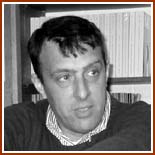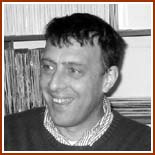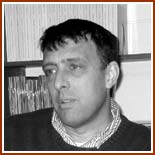 |
|
 "Most people killed in bushfires in southern Australia die with the passage of the cold front. When the fire changes direction, people are trapped."  "Suppose we had a fire in the Dandenongs and there was a wind change. Where would the fire go?"  "With a vortex, you get a jet of flame bursting forward, the height of pine trees. We're looking at almost a 100-foot flame. This is how fires spread."  "When we have a very hot region, the atmosphere heats, and hot air rises and produces its own winds. In some instances you can generate a tornado."  "It's in the really big fires, which only come along every so often, that people don't have the experience. You don't know quite what is going to happen." |
Michael Reeder Reader in Applied Mathematics in the school of Mathematical Science at Monash University. Currently applying mathematical formulas to create models of fire behaviour. 
I got into fires when I was on sabbatical in the US, at the National Centre for Atmospheric Research. One of my colleagues there, Terry Clarke, was working on numerical models of fire, and he invented this area I currently work in. While I was there, he was quite keen that we collaborate on bushfires. It is such an important problem in Australia and it's fundamentally a problem in meteorology as well, and fluid mechanics. So it did mesh in with the sort of things I was thinking about. I've worked on problems to do with fronts and convection, which is a key component of the bushfire problem here in Australia. With fronts, for example, most of the people killed in bushfires in southern Australia die with the passage of the cold front. When the fire changes direction, people are trapped. The convection aspect is that the fire itself is essentially a problem in convection, overturning, heating and overturning of the atmosphere. What we have done is developed a mathematical model which seems to describe the motion of the fire: the intermittence, the randomness, the way in which the fire produces a parabolic shape, the way in which it breaks up at times. So we have a basic tool for investigating fires and, for example, how their behaviour changes in mountainous terrain, or with different wind conditions. The next step is to take more complicated patterns of wind and more complicated patterns of terrain, and to use this model to say what happens when we have a fire in those situations. Suppose we had a fire in the Dandenongs and there was a wind change. Where would the fire go? One of the examples we used in the early work was to light a fire with a constant background wind. We looked at the basic equation of motion, the conservation of mass and energy and some basic chemistry combustion of the problem. By solving all of those problems we ended up with a very good simulation of a fire. It simulated the turbulence, the motion of the fire, the way it breaks up into smaller segments and so on. The basic physics of the fire. A fire with a background wind is very simple. Now we have been working on how to introduce rather more complex topography and wind patterns, such as the topography of the alpine regions of southern Australia, or the Dandenongs, or whatever. The really interesting thing is that you can then ask the question, "If I lit a fire here, and there were certain atmospheric conditions, a cold front was coming along, what would happen? Where would the fire go? Who would it affect, what would it look like?" One of the problems in verifying the right model is that you get people fighting the fires, of course, and they change the course of the fire. So we went up to the Northern Territory and with the help of the local fire agencies, we lit some fires in a disused airfield. We took infrared images of the fires, and with those images you can use image flow technique to ask how the individual elements move around, and calculate wind speeds and velocities and things like that. Then you can compare those with what the models are predicting - how fast the fire moves in the model versus how fast the fire moves in reality, and so on. You've got a way of testing whether your models are working or not. The next step in this is to start to examine more intense fires. Of course, you can only light fires in relatively benign conditions, and we really want to know how fires behave in extreme conditions, such as Canberra, or Victoria in 1939. So that is the goal. It is useful because you can answer questions like, "If a fire went through here like in 1939, where would it go and what would it do?"  For example, you might ask the question, "I want to do some back burning. I need to know where the fire will go". With variable wind conditions, fires are very complex animals, and you need to go beyond simple rules and into these more complex models to describe the behaviour of the fire more accurately. For example, you might ask the question, "I want to do some back burning. I need to know where the fire will go". With variable wind conditions, fires are very complex animals, and you need to go beyond simple rules and into these more complex models to describe the behaviour of the fire more accurately.This is really what happened with weather forecasting. In the 1950s people were using simple weather rules and it wasn't getting them very far. Computers were invented in the 50s and one of the first problems they were applied to was weather forecasting. From then on we have jumped ahead in leaps and bounds, and it is one of the leading areas in this sort of numerical fluid dynamics. That is what we are just starting to do in fires. We didn't really have the computing powers until recently, or the technology to solve these sort of problems. We do now, so we're just catching up to weather forecasting now. The main reason that bushfires are interesting to me is that it's an extremely interesting area of fluid mechanics and mathematics with real practical applications to people. Bushfires affect people, our environment, our natural resources and our water, our catchment areas very profoundly. I like to be able to apply mathematical and physical ideas to environmental problems, to real problems. Mathematical ideas have been applied to bushfires in the past, but the problem is that you have to crunch so many numbers to solve the equations in detail, and the computing power required has only just become available. I'm not trying to forecast a fire in the way that you forecast the weather. I can't forecast whether there will be a fire tomorrow, and for the foreseeable future, I couldn't forecast in real time where that fire would go. At present, we simply don't have the detailed information fast enough to run a model like this. It is a possibility, but not in the immediate future. What I think you can do is influence policy with these kinds of models. You can understand how the fire works and what would happen under certain conditions. And perhaps it is also about training. People who manage these really huge fires probably only see one or two of them in their lifetime. In the longer term, I think you could probably use this to help train people. We could simulate fires on a particular day and in a particular location. You could say, "Okay, this is what is going to happen. Can we set up a training program, can we get people to simulate what is going to happen and simulate their response?" The other area where I think it probably has application is in fuel management. An agency might say, "Okay, we need to reduce the fuel in this area. We need to do some burning tomorrow." We could make a forecast of what the fire will do in this particular area, so you don't have any rude shocks awaiting you. One of the things we are really aiming at is to be able to say things about intense fires. The sorts of fires where you can't go out and light it safely and then have people practice on it to get experience. It's in the really big ones, which only come along every so often, that people don't have the experience. You don't know quite what is going to happen. That is what we want to be able to simulate accurately, and that is why what we're doing is so different to things that have been done in the past.  In the past people have gone out and lit fires, observed them and taken measurements, then produced a statistical model. That is fine, and they've been quite successful, too, but what about those cases where you can't go and take observations because you don't know what is going to happen? In the past people have gone out and lit fires, observed them and taken measurements, then produced a statistical model. That is fine, and they've been quite successful, too, but what about those cases where you can't go and take observations because you don't know what is going to happen?By getting away from only basing our understanding on observations, we can use these mathematical tools to ask questions about things we haven't observed yet. More intense fires, for example. When we have a very hot region, the atmosphere heats, and hot air rises and produces its own winds. There is the effect of actually burning the fuel, but also the effect of the air flow, and in some instances you can generate a tornado. It's like generating a vortex in your bath. If the water is sucked down the drain, and they produce this vortex, here we've got the air rising very rapidly producing a similar upside version. That could happen. With a vortex, you get a jet of flame bursting forward, the height of pine trees. We're looking at almost a 100-foot flame. That's a possibility. This is a very extreme example, but this sort of thing happens all the time on a much smaller scale in fires. This is how fires spread. What can happen is that as the fire reacts with the wind, it produces two little vortices on either flank of the fire. The wind field is pushing the central part of the fire faster than it would otherwise be going. What is taking shape is really an interaction between the fire and the background wind. That is why it's so important to have models of fires that are coupled to the atmosphere. It is not just a one way thing, a model of a fire. It's a fire and the atmosphere coupling together. When two fires collide, you do get a more intense fire. One of the things we would like to do is light two fires and look at the interaction. We can look at a fire that is propagating along and you might decide to do some back burning, and under what circumstances will that second fire that you've deliberately lit be drawn into the original fire, which happens occasionally. The only fires I've ever been involved with are ones that have been deliberately lit, that is experimental fires. I've seen video of fires taken by volunteers, and you can imagine they must be very frightening. It probably depends on people's backgrounds. I find it interesting from an environmental/physical/mathematical perspective. I'm interested in how the world works, but I'm even more interested in how the world works when it affects people. I guess it is that combination. Working on this kind of project, you do have an emotional response, although it's obviously not the same response as someone who has lived through a bushfire. Someone who has lived through a bushfire where it's really affected them and burned their house down and injured their family - that's a very different experience from someone who is writing mathematical theories on these things. But you do have an emotional response, that's for sure. Read more about the unpredictable behaviour of bushfires in 1939 in the Oral History Section |
The Scientists
Bill Wright
Climatologist Bureau of Meteorology David Packham Fire Managment Consultant, Indonesia David Ashton Doctor of Science, expert on the mountain ash forests Mike Reeder Reader in Applied Mathematics at Monash University. Kevin Tolhurst Fire ecologist based at University of Melbourne, Creswick Campus |
 |